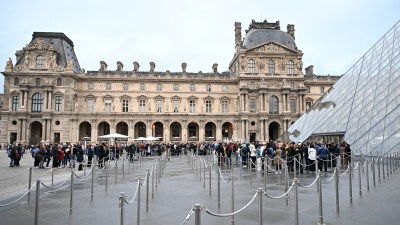Blue strains from the yellow metal
They sure do want to ensure cleanliness, you'd think, as you see these people zealously sweeping the stairway and landings of a dingy buildi...

They sure do want to ensure cleanliness, you’d think, as you see these people zealously sweeping the stairway and landings of a dingy building in Raviwar Peth, near Sonya Maruti Chowk, and then carefully carrying away the mud and dirt. Unfortunately, it’s not the cleanliness drive that goads them, but the gold rush!
For this is the working place of 40-odd gold artisans (karigars) in the city who make those dazzling ornaments that lure you into jewellery stores. And as they chisel and carve away from solid gold, the gold dust sprinkled around attracts another set of persons, who hope to sift the precious from the worthless.
“But at least they may get something; at the end of the day, we have nothing,” sighs Naresh Dusane, who specialises in gold bead work. One need not even listen to the lament in his voice to know that behind the scenes, things are not as beautiful as the bauble one dabbles in.
The grubby cubby-holes (taken on rent), no bigger than five by five feet, the smoke the artisans inhale as they bend over gas burners and kerosene flames, their watering eyes as they look up…the pathetic work conditions are there for you to see.
And this is the birthplace of exquisite necklaces and chains, bangles and rings. Moulding the ornaments into their final form are different categories of artisans – those who do the styling, the taaskaam, the manikaam, the welding and the polishing.
“Our working day dawns at 8.30 am and sets only late at midnight,” says Dusane. “Once we get the order from either the jeweller we work for, or in some rare cases, directly from the customer, the process gets into gear. The final phase being the polishing (using acids and other chemicals), those workers need more space and do not work here.
“Each of us has his specialisation; I do manikaam (perfecting the gold beads, joining them in the requisite design),” says Vijay Chikalkhankar. But they all work together. Dusane and Chikalkhankar share their chamber along with three others. This does not mean that all of them work for the same person, they just sit together.
Each of these rooms accommodates as many persons as possible. “We only need that much space as we take to sit with a table before us,” says another worker, who has come here all the way from Rajasthan. “Things are not so bad, we make it a point to get up and walk about every once in a while,” he adds.
But he is one of the few who function as a group and hence have a more organised set-up. Their work space is comparatively bigger, with exhaust fans and even cordless phones. This, needless to say, is an exception amongst the rest who in their working conditions far from satisfactory.
“We cannot afford exhaust fans, and the heat gets unbearable. It’s not feasible to keep the windows open always as each one requires to use the burner at different times,” shrugs Dusane. “And who has the time to go and take a walk? Our backs hurt like hell, but there’s no space to even stretch out.” His friend points out that these conditions have had far-reaching consequences – like reducing their working age. “We cannot work after 40 to 45 years of age.”
Maybe they themselves are somewhere to blame. Dusane acknowledges that “we have not got together to form an association, and so cannot demand our own terms.” This extends to the monetary aspect too. As of now, there are no fixed rates and the jeweller approaches any worker who quotes the lowest price and gets his work done. Competition is tough these days.
“We have no interaction with the customer. Our prices depend on the price of gold at that moment in the market and some majoori, which again is not in tandem with what the customer pays,” says Chikalkhankar. “There’s no social security, no steady income. Gold is like poison to us,” he says with disgust. “Working the whole day with gold, we cannot afford it for our wives,” adds his colleague.
But their trust in each other is rock solid, professional competition notwithstanding. “I can walk out leaving the ornament on my work table, and I know it will be right there untouched when I get back. But the jeweller makes sure he weighs the gold he gives us and weighs the ornament when he takes it back,” says Dusane.
Things have not changed in the 20-odd years that these people have been in the field. “We will not let our children enter this trade,” asserts Dusane and that is indication enough that all that’s behind the gold is definitely not golden.





- 01
- 02
- 03
- 04
- 05


























